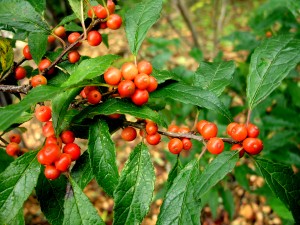
Now that we are firmly planted in Autumn, many deciduous plants have begun to shed their leaves. At this time of year, shrubs with showy berries really prove their worth in the landscape. One of the best for fall berries is Ilex verticillata.
Although there is a range of color in the various cultivars and hybrids, red is still the most prevalent in this species. The tips of the branches are covered in berries this time of the year. The berries cling to the twigs long after Christmas Stroll, even when cut and used to accent lying, wreaths, and planters. That’s why so many landscapers and home gardeners use it for seasonal decorating.
Winterberry loves low lying, moist, fertile areas. It will do well in part shade, but situated in full sun, it will produce the most berries. Keep in mind that these plants are dioecious, meaning male and female flowers are produced on separate plants. I order to ensure good pollination of the berry-producing females, it’s a good idea to plant at least one male for ever 20 females. That male can be located up to 50 feet away. If your new planting is on an area of the island with lots of native winterberry, you might not need to plant males, but it’s a good practice, just to hedge your bets.
The other consideration for heavy fruit-set is that most cultivars are best pollinated by different varieties. For example, the late flowering ‘Winter Red’ is best pollinated by ‘Southern Gentleman’, or ‘Apollo’ which also flowers later in the season. ‘Red Sprite’ on the other hand, is best pollinated by ‘Jim Dandy’.
NOTE: The Polly Hill Arboretum on Martha’s Vineyard has been doing work with winterberries for a number of years. We recently contacted them to see if they had any recommendations for good winterberries on the Cape and Islands. ‘Winter Red’ was their cultivar of choice.
